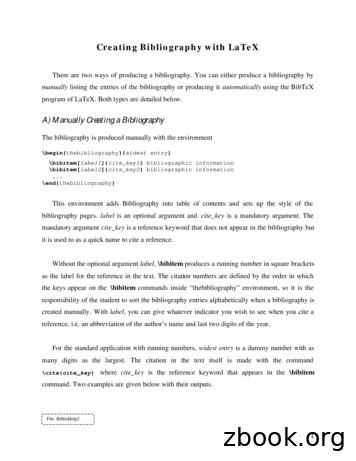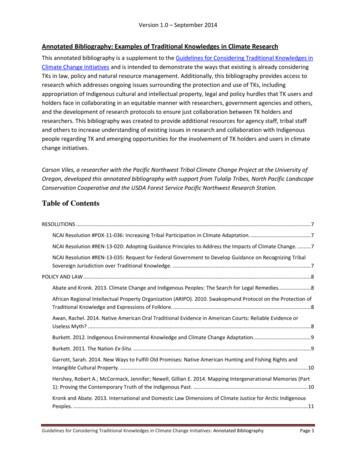Leadership Annotated Bibliography
LeadershipWorkplace Learning Annotated BibliographyPage 1
Leadership Annotated BibliographyPrepared by the NIC Information CenterCreated December 2013, Revised September 10, 2016Accession No. 025971An electronic copy of this document can be found at: www.nicic.gov/Library/025971ContentsIntroduction . 2General . 3Various Leadership Types . 5Adaptive Leadership . 5Authentic Leadership . 5Change Leadership . 6Emotional Intelligence. 6Ethical Leadership . 7Leader-Member Exchange (LMX) . 8Servant Leadership . 9Transformational Leadership. 10Virtuous Leadership . 11Leading Generations . 13Women and Leadership . 15Leadership and Diversity . 17Leadership Development . 18Leadership in Corrections. 20Succession Planning . 23Leadership Annotated BibliographyPage 1
IntroductionThis annotated bibliography provides current and useful information about leadership tocorrections professionals. There are many different theories about leadership. A leader needs to beaware of them because different styles of leadership may be needed for differing situations. In theend, results of good leadership will include high morale, employee retention, and sustainablesuccess over the long run. This bibliography touches on a few of the main theories, and looks at theimpact of leadership on various groups and succession planning.Leadership Annotated BibliographyPage 2
GeneralBerger, Joseph B. "Leadership: A Concise Conceptual Overview." Center for International EducationFaculty Publications, Paper 18 (2014). Accessed September 13, .cgi?article 1017&context cie faculty pubs."Leadership is a daunting endeavor that requires hard work, multiple tools (conceptualknowledge, practical skills, and value-based integrity), and collective effort. Therefore, thepurpose of this short article is to introduce a conceptual map that provides categories ofmajor approaches to leadership with a discussion of how each approach contributes to amore comprehensive understanding of leadership. This article also serves as a quickintroductory overview and does not go into great depth on any topic; rather it is designed toprovide a conceptual framework of what tools are available and how they relate to eachother " (p. 1-2).Copeland, Mary Kay. "The Emerging Significance of Values Based Leadership: A Literature Review"International Journal of Leadership Studies 8, no. 2 (2014): 105-135. Accessed September 13, s/ijls/new/vol8iss2/6-Copeland.pdf.Values based leadership (VBL) "behaviors are styles that have a moral, authentic and ethicaldimension. This study examines the prevailing literature and research on the variousconstructs rooted in VBL. It identifies three constructs [authentic, ethical, andtransformational leadership] that are considered the most emphasized behaviors in theVBL literature and examines the literature streams and progression of research for each ofthese VBL theories. The study identifies literature that supports that when these VBLbehaviors are found in leaders, the leaders are evaluated as more effective by subordinates"(p. 105).Day, David V., John W. Fleenor, Leanne E. Atwater, Rachel E. Sturm, and Rob A. McKee. “Advances inLeader and Leadership Development: A Review of 25 Years of Research and Theory.” LeadershipQuarterly 25, no. 1 (2014): 63–82. Accessed September 13, 42048 Advances in leader and leadership development A review of 25 years of research and theory."The development of effective leaders and leadership behavior is a prominent concern inorganizations of all types. We review the theoretical and empirical literature on leader andleadership development published over the past 25 years, primarily focusing on researchpublished in The Leadership Quarterly. Compared to the relatively long history ofleadership research and theory, the systematic study of leadership development (broadlydefined to also include leader development) has a moderately short history. We examineintrapersonal and interpersonal issues related to the phenomena that develop during thepursuit of effective leadership, describe how development emerges with an emphasis onmulti-source or 360-degree feedback processes, review longitudinal studies of leadershipdevelopment, and investigate methodological and analytical issues in leader and leadershipdevelopment research" (p. 63).Leadership Annotated BibliographyPage 3
Landis, Eric A., Deborah Hill, and Maurice R. Harvey. 2014. “A Synthesis of Leadership Theories andStyles.” Journal of Management Policy & Practice 15, no. 2 (2014): 97–100. Accessed September 13,2016. http://www.na-businesspress.com/JMPP/LandisEA Web15 2 .pdf."'Leadership is one of the most widely talked about subjects and at the same time one of themost elusive and puzzling" In an effort to thoroughly comprehend the different theoriesreviewed, this article will focus on the theories of leadership and define strategies that willmaintain a collaborative working relationship and respectful team environment in a groupsetting." (p. 96).Ngang, Tang Keow. 2012. "Leadership Soft Skills." Sociology Study 2, no. 4 (2012): 261-269.Accessed September 13, g/upfile/6/29/2012/2012062971590721.pdf."This paper mainly discusses leadership soft skills, which comprise of collaboration orteamwork, communication skills, initiative, leadership ability, people development orcoaching personal effectiveness of personal mastery, planning and organizing, andpresentation skills. Leaders need to be master of skills because leadership is determined bythose who can demonstrate their ability to drive an organization toward excellence andresults" (p. 261).Orazi, David, Laura Good, Mulyadi Robin, Brigid van Wanrooy, IB Butar, Jesse Olsen, and PeterGahan. "Workplace Leadership: A Review of Prior Research." Carlton, VIC: University of MelbourneFaculty of Business and Economics Centre for Workplace Leadership, 2014. Accessed September13, 2016. his review "explores the skills and capabilities individuals require to be effective leadersand how these can be acquired. It examines different leadership styles and the outcomes,both positive and negative, for employees, teams and organisations. The review concludesthat leadership skills and capabilities can be learned, and it explores how these can bedeveloped through different approaches and interventions. (Author abstract, modified)Thinking about Leadership: A Brief History of Leadership Thought. Phillip, ACT: Australian PublicService Commission, 2014. Accessed September 13, 2016. history-of-leadership-thought.This paper provides key points, general information, criticisms and challenges, andresources for further reading for five leadership theories from 1840 to 1980 (trait-based,situational, contingency, and transactional, and transformational) and four contemporaryleadership theories (authentic, adaptive, neuroleadership, and complexity).Leadership Annotated BibliographyPage 4
Various Leadership TypesAdaptive LeadershipAdaptive Leadership Reference Guide v.1.0. 2015. Accessed August 23, -Guide.pdf.This participant manual from an adaptive leadership training program covers the following:the Adaptive Leadership Iterative Framework; adaptive leader characteristics; adaptiveleadership iteration; what adaptive leadership is; broaden our perspective; Iceberg Model;Double Loop Learning—Argyris and Schon; managing complex change; Kotter's 8 StepChange Model; Cynefin Framework; Polarity Mapping; strategic change canvas; metrics thatmatter; creating a learning organization; adaptive leadership actions; Adaptive LeadershipOODA (observe, orient, decide, act) Loop; robust dialogue and fierce conversation--theimportance of robust dialogue; and Personal Agility Canvas.Heifetz, Ronald, Alexander Grashow, and Marty Linsky. The Practice of AdaptiveLeadership: Tools and Tactics for Changing Your Organization and the World. Boston: HarvardBusiness Press, 2009.The use of adaptive leadership to deal with challenges in an ever changing environment isexplained in five parts--purpose and possibility, diagnosing the system, mobilizing thesystem, seeing yourself as a system, and deploying yourself. An executive summary of thisbook can be found athttps://www.academia.edu/23426901/Heifetz Linsky and Grashow in The Practices of Adaptive Leadership Tools and Tactics for. Accessed September 13, 2016.Authentic LeadershipAlgera, Puck M., and Marjolein Lips-Wiersma. “Radical Authentic Leadership: Co-creating theConditions Under Which All Members of the Organization Can be Authentic.”Leadership Quarterly 23, no. 1 (2012): 118-131. Accessed August 23, efault/Resources/LEAQUA805.pdf.Recently, in response to ethical challenges and loss of meaning within business, leadershiptheory and research has seen a proliferation of literature on ‘Authentic Leadership’. In thispaper we argue that Authentic Leadership (AL), in the way it is currently theorized, is indanger of not reaching its stated objectives. We systematically address the “paradoxes” andshortcomings in current theory and suggest an extended focus of study" (p. 118).Leadership Annotated BibliographyPage 5
Change LeadershipDuncan, Roger Dean. Change-Friendly Leadership: How to Transform Good Intentions into GreatPerformance. New York: Maxwell Stone Publishing/Midpoint Trade Books, 2012.The author "has created a user-friendly implementation guide to help buffer the shock wavethat often accompanies change. But most importantly, he compellingly teaches us not onlyhow to shepherd our own way through change, but also how to engage others along thepath” (p. xviii). An executive summary can be read athttp://www.johnbesaw.com/ChangeFriendly Leadership.online.pdf. Accessed September 13,2016.Gerschel, Antoine, and Lawrence Polsky. Rapid Retooling: Developing World-Class Organizations in aRapidly Changing World. Alexandria, VA: ASTD Press, 2013.This book describes best practices for rapid retooling and offers real-world case studiesshowing how the process works. “Simply put, rapid retooling is what successfulorganizations are doing to keep ahead of the rapid pace of change. They respond totechnological and economic pressures by quickly refocusing, retraining, and reenergizingtheir employees to achieve results” (p. 2).Emotional IntelligenceLopez-Zafra, Esther; Garcia-Retamero, Rocio; Berrios Martos, M. Pilar. “The Relationship BetweenTransformational Leadership and Emotional Intelligence from a Gendered Approach.” PsychologicalRecord 62, no. 1 (2012): 97-114. Accessed September 13, 26150 The Relationship between TransformationalLeadership and Emotional Intelligence from a Gendered Approach."In this study, we investigated the relations among transformational leadership, emotionalintelligence, and gender stereotypes Results showed important differences across thedifferent disciplines and illustrated that emotional intelligence and gender roles predicttransformational leadership. These results are interpreted in line with current research onthe topic of leadership and emotional intelligence" (p. 97).Sharma, Sartosh. "Theory & Relationship between Emotional Intelligence, Leadership Styles andLeadership Effectiveness." International Journal of Education and Science Research 1, no. 5 (2014).Accessed September 13, 2016. 5-15E.pdf."Today effective leaders are defined by inspiring and motivating others, promoting apositive work environment, understanding and managing emotions, building bonds,communications, influence, and so forth. Emotional Intelligence (EI) has an emerging trackrecord of being linked to leadership performance. Emotional intelligence connects a leader’scognitive abilities with their emotional state. The ability for leaders to recognize the impactof their own emotions on their decision making is paramount if a leader is to make sounddecisions based on the best interests of the organization" (p. 104).Leadership Annotated BibliographyPage 6
Walter, Frank, Michael S. Cole, and Ronald H. Humphrey. "Emotional Intelligence: Sine QuaNon of Leadership or Folderol?" Academy of Management Perspectives 25, no. 1 (2011): 45-59.Accessed September 13, 0Leadership.%20AMP.pdf."Emotional intelligence (EI) is a divisive topic for many individuals interested in the subjectof leadership. Whereas practitioner-oriented publications have claimed that EI is the sinequa non of leadership, academics continue to discuss EI's relevance for understandingleadership emergence, behavior, and effectiveness. Here we critically review recentempirical evidence to constructively frame what has become a contentious debate about therelevance of EI. We also identify unresolved issues and highlight future research directionsthat may promote our understanding of EI's role for leadership. We close with a practicaldiscussion of possible applications of EI in leadership education, training, and development"(p. 45).Walter, Frank, Ronald H. Humphrey, and Michael S. Cole. "Unleashing Leadership Potential: Towardan Evidence-Based Management of Emotional intelligence." Organizational Dynamics 41, no. 3(2012): 212-219. Accessed September 13, t%20of%20EI Org%20Dynamics.pdf."Can one reasonably expect emotionally intelligent leaders to perform more effectively —or is emotional intelligence just another empty management fad? Are companies welladvised to incorporate emotional intelligence into their leader selection, promotion, anddevelopment efforts — or should they focus on other, more promising concepts? We aim toprovide answers to these questions." (p. 212).Ethical LeadershipGini, Al, and Ronald M. Green. “Three Critical Characteristics of Leadership: Character, Stewardship,Experience.” Business & Society Review 119, no. 4 (2014): 435–446."There is no one definition of leadership. The leadership equation is never set or fixed.Time, place, specific problems, the particular parties involved all play a role in theleadership equation. Nor is there one specific list of attributes, virtues, or skills that allleaders must and do possess. Nonetheless, we argue that at its core, all forms of ethicalleadership are based on three elemental ingredients: character, stewardship, andexperience" (p. 435).Gini, Al, and Ronald M. Green. 10 Virtues of Outstanding Leaders: Leadership and Character. NewYork: Wiley-Blackwell, 2013.Leadership Annotated BibliographyPage 7
The authors write "about characters with character. After several chapters that ground theimportance of ethics in business and present the key virtues of outstanding leaders, we turnto those leaders themselves. As Aristotle argued, we need examples, the testimony of others,to understand how to form ourselves as leaders. In what follows, chapter by chapter, wedepict individuals who in real-life situations act out the virtues that marked them as greatleaders. Learning virtues is very much a matter of habit and imitation. By holding up theseparagons of virtue, we aim to provide a useful tool for enhancing excellence inorganizations" (p. xiv). An executive summary can be found ers.pdf.Lakshmi, B. "Leadership Ethics in Today's World: Key Issues and Perspectives." ASCI Journal ofManagement 41, no. 1 (2014): 66-72. Accessed September 13, 2016.http://asci.org.in/journal/AJoM 44%20(1)%20Sep%202014.pdf."The concerns about failure of leadership extends to all institutions and groups andcommunities are responsible for social change whether they are governments, businessorganisations or civil society groups. These concerns are being voiced at a time of highexpectations among citizens that leadership can address the political, economic, social andmoral challenges of their societies. In the present global context, unethical conduct byleaders has brought ethics to the centre of discussion on leadership and its role in today'sworld. What constitutes 'leadership ethics?' How do we bring ethics into leadership inpractice? This paper looks at the importance of Leadership ethics as the main theme with anoverview of the key issues and perspectives on ethical leadership in theory and practice" (p.66).Lawton, Alan, and Paez Iliana. "Developing a Framework for Ethical Leadership." Journal of BusinessEthics 130, no. 3 (2014): 639-649. Accessed September 13, 22258 Developing a Framework for Ethical Leadership."Interest in ethical leadership from academics and practitioners has gro
leadership development published over the past 25 years, primarily focusing on research published in The Leadership Quarterly. Compared to the relatively long history of leadership research and theory, the systematic study of leadership development (broadly defined to also include leade
Part - I Short Bibliography 1-33 Part I contains the short (not annotated) references of this bibliography, alphabetically sorted by author. Subject to availability, we provide hyperlinks/website addresses for each item. As of January 5, 2010, this bibliography contains 406 items. Part - II Annotated Bibliography 34-203
Setting up your NHD Annotated Bibliography Create a word document just for your annotated bibliography. See the examples for how to format the bibliography. Your full name Use Arial, Times, or any easily read font. Do
annotated storyboard for TV ads, annotated patient brochure) o1.15.2.1.3 Annotated labeling version: Annotated approved product labeling (PI, PPI, Medication Guide) o1.15.2.1.4 Annotated references: Annotated references for
An Annotated Bibliography Prepared by Pastor Marty Baker July 2014 Before you start perusing my annotated bibliography, permit me to first share a couple of things . The list does not contain the other 5,000 biblical books I possess and read with my Logos Bible software. By the way, this is
6 Bibliography Style A bibliography style has to be chosen. The bibliography style can be declared with \bibliography{style} command, which may be issued anywhere after the preamble.The style is a file with .bst extension that determines how bibliography entries will appear at the output, such a
An Annotated Bibliography of Published Materials on Puerto Ricans Compiled and Annotated by Marisa Rivera Iowa State University W orking Paper No. 30 June 1997 About the Author: Marisa Rivera Ms. Rivera is a doctoral candidate in Youth and Huma
western dialogue editorial eulogy autobiography speech tabloid article romance photograph internship/fellowship application . an introduction to a main character . Cartoon: The Capture Epilogue Bibliography Back to title page . Annotated Bibliography What is an annotated bibliography? An annotation is a brief description of the source. You are
This annotated bibliography is a supplement to the Guidelines for Considering Traditional Knowledges in Climate Change Initiatives and is intended to demonstrate the ways that existing is already considering TKs in law, policy and natural resource management. Additionally, this bibliography provides access to






















